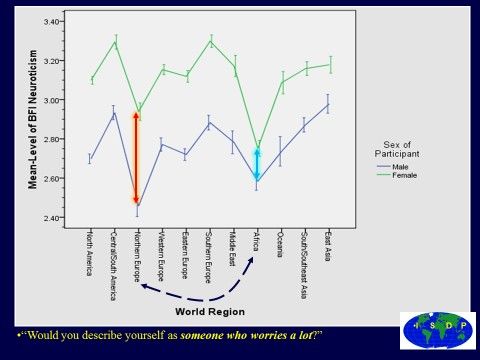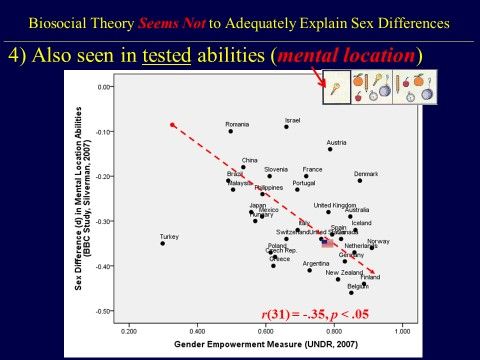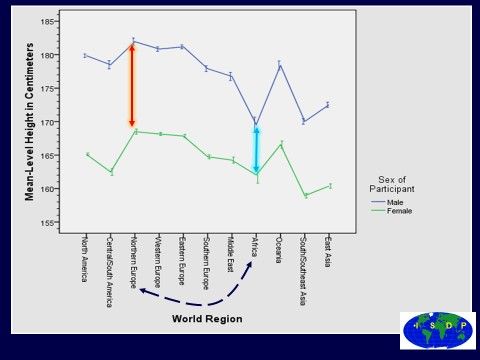понедельник, 13 апреля 2015
Are Women More Emotional Than Men?
Women’s negative emotionality as experienced around the world
Post published by David P Schmitt Ph.D. on Apr 10, 2015 in Sexual Personalities
Are women more emotional than men? Maybe. Men could be described as more emotional than women, too. It depends on the type of emotion, how it is measured, where it is expressed, and lots of other factors. It is also important when answering that type of question not to dichotomize sex differences as necessarily being either “entirely absent” (i.e., gender blank slate-ism) or so large that men and women “can’t relate to one another” (i.e., the old Mars versus Venus claptrap). Most psychological sex differences fall somewhere in the middle (Petersen & Hyde, 2010).
From an evolutionary perspective, it is likely there are some sex differences in emotion. Indeed, the odds of men and women having evolved the exact same emotional psychology are basically zero. It would be nothing short of a Darwinian miracle for men and women to have evolved precisely identical emotional designs. The forces of selection acting on humans would have had to eliminate all previous sex differences in emotionality stemming from our lineage as mammals and primates, actively select against any and all sex-specific emotional adaptations developing during our hundreds of millennia as hunter-gatherers, and maintain a perfectly androgynous psychology of emotion in men and women post-Pleistocene epoch (Buss & Schmitt, 2011). For one to expect absolutely no sex differences in human emotion, one would have to believe in a god/godess-like creature, Androgyna, having actively intervened throughout all of human history to make sure men and women reproduce in ways that maintain precisely the same emotional psychology. As Vandermassen (2011) has noted, “that human males and females should have evolved to be psychologically identical, for example, is a theoretical impossibility, and, indeed, turns out to be untrue” (p. 733).
Still, any particular scientific claim about men and women being emotionally different needs to be evaluated empirically. And finding sex differences in emotionality would not mean the differences are evolved, even if the sex differences have neurological substrates (gender role socialization may change the brains of boys and girls). The evolved question requires a lot more evidence (see Schmitt & Pilcher, 2004).
сайенс
So, are there some apparent sex differences in emotion, and how big are those differences (using the d statistic where small differences are ±0.20, moderate differences are ±0.50, and large differences are ±0.80 and above)? Probably the most compelling evidence for sex differences in emotion exists in the domain of negative emotions (Brody & Hall, 2008; McLean & Anderson, 2009).
For instance, in a meta-analysis of sex differences in the feeling of “moral” emotions (Else-Quest et al., 2012), women tended to experience more negative emotions, such as more guilt (d = −0.27), shame (d = −0.29), to a lesser degree embarrassment (d = −0.08). Similar results were found in a recent meta-analysis of children’s emotions (Chaplin & Aldao, 2013). In a cross-cultural study of 37 nations, women tended to report more negative emotionality (Fischer et al., 2004). Among those nations with relatively higher sociopolitical gender equity, sex differences were found in the intensity of felt sadness (d = -0.26), fear (d = -0.26), shame (d = -0.12), and guilt (d = -0.12; Fischer & Manstead, 2000). Sex differences in social anxiety across cultures find women are universally higher than men (18 nations; Caballo et al., 2014), as do studies of test anxiety among high school students (12 nations; Bodas & Ollendick, 2005). Most these sex differences in negative emotion are relatively small, though. No Mars versus Venus here.
In studies using experience sampling or measures other than self-report (e.g., observer reports or clinical evaluations), sex differences in the actual daily life experience of negative emotionality are usually found (Diener et al., 1983; Fujita et al., 1991; Seidlitz & Diener, 1998), but not always (Barrett et al., 1998). Sex differences in the stressful reactions to coping with negative daily life events also have been found (Matud, 2004), and observation data of women’s written and verbal behavior tends to find women express more negative emotions than men do (e.g., Burke et al., 1976; Levenson et al., 1994). It’s important to note which situations tend to elicit negative emotionality in relationships, however. Women report more negative emotionality when their partners reject them, men tend to report more negative emotions when their partners demand more intimacy (Brody et al., 2002).
Women do appear to react more negatively to unpleasant experiences in experimental settings (Bradley et al., 2001; Chentsova-Dutton & Tsai, 2007; Grossman & Wood, 1993). For instance, in a study of sex differences in reactions to pleasant and unpleasant slides (Gomez, Gunten, & Danuser, 2013), researchers found women reacted more negatively to unpleasant slides (e.g., mutilated bodies, physical violence, and suffering or dead animals), a sex difference that persisted in size from ages 20 to 81. Kring and Gordon (1998) found women react with more sadness to sad films than men do (d = -0.78) and women react with more fear-disgust to fearful-disgusting films than men do (d = -0.40). In contrast, men reacted with greater happiness to happy films (d = +0.31). Men and women appear to differ in the brain regions used to regulate reactions to unpleasant experimental stimuli, as well (Domes et al., 2010; McRae et al., 2008).
Women tend to be able to recognize and process the negative emotions of others better than men do (Babchuck et al., 1985; Hampson et al., 2006; McClure, 2000). There are several evolutionary hypotheses about why this is the case. For instance, women may be more sensitive to all the emotions of others because of their need (more than men) to attach with their children, or women may be especially responsive to negative emotions only because of the need to react to fitness threats more than men do. Hampson and her colleagues (2006) found more support for the former hypothesis.
Most studies show women tend to score higher on the personality trait most closely associated with negative emotionality—neuroticism (Feingold, 1994; Schmitt et al., 2008). In a meta-analysis across 25 studies, for instance, Feingold (1994) found women score higher in anxiety (d = -0.27). Several large cross-cultural studies have confirmed these sex differences across dozens of nations (Costa et al., 2001; Lippa, 2010; Schmitt et al., 2008). Women have been found to score higher in overall neuroticism in a studies of 26 nations (d = -0.26; Costa et al., 2001), 53 nations (d = -0.41; Lippa, 2010), and 56 nations (d = -0.40; Schmitt et al., 2008).
Interestingly, all of these cross-cultural studies find sex differences in neuroticism are larger in cultures with more sociopolitical gender equity. That's right, in more gender egalitarian nations sex differences in neuroticism are larger, not smaller as would be expected if sex differences come only from gender roles, learning, and patriarchy (see chart below contrasting neuroticism scores of men and women from Northern Europe and Africa; Schmitt, 2015).

Similar results are found in studies depression. Men and women tend to differ in average levels of depression (Hyde et al., 2008), a sex difference that is apparent in most cultures (Hopcroft & McLaughlin, 2012; Van de Velde, Bracke, & Levecque, 2010). The sex gap in depression is wider in high gender equity societies than in low gender equity societies. Hopcroft speculates that this is due in part to differential effects of children on feelings of depression for women in high and low equity countries. For women in high gender equity countries, children promote feelings of depression, whereas for unemployed women in low gender equity countries the reverse is true. There is little difference in the effect of children on feelings of depression for men in high and low gender equity countries. This can explain the paradoxical finding that while gender equity boosts mental health on average, it creates a wider sex gap in depression.
Similar results are found in studies of personal values, including values related to altruism and love. In a study of 127 samples in 70 countries (N = 77,528; Schwartz & Rubel-Lifschitz, 2009) women attribute consistently more importance than men do to benevolence and universalism values. National measures of gender egalitarianism predicted sex differences in benevolence and universalism values but, once again, in an unexpected direction. The greater the social, health, and employment equality of women and men in a country…the larger the sex differences (women higher) in benevolence and universalism values. That is, in countries with greater gender equity (e.g., Finland, Sweden), women attribute substantially more importance to benevolence and universalism values than men do. In more patriarchal cultures, sex differences in benevolence and universalism and much smaller. The authors of the values study speculate that increased independence and equality of women in the labor force may encourage women to express their “inherent” values rather than to accommodate their values to those of their husbands. Maybe.
What is clear is that if sex differences are assumed to result from gender role socialization, it is extremely odd for the largest sex differences to be found in Scandinavian cultures and the smallest in more patriarchal cultures. Yet, we also find this with studies of tested cognitive ability and even physical traits (see charts; Schmitt, 2015).


Finally, I’d say if one’s goal is to provide an accurate portrayal of men and women possibly differing in their psychology in a particular domain, it is probably best to evaluate the degree of difference using multivariate statistics within that specific domain. For instance, Del Guidice et al. (2012) examined sex differences in personality using Cattell’s 16 factor model of personality traits, finding an overall multivariate D of 2.71 for the personality domain. This is huge difference, with less than 10% overlap in men’s and women’s personalities. Emotion-related traits are only a small part of that profile of sex differences, though. My guess is, in taking a multivariate perspective of the emotional domain, researchers will find emotion differences between men and women are more moderate in size. Same planet, different neighborhoods.
www.psychologytoday.com/blog/sexual-personaliti...
@темы:
феминизм,
социальное


